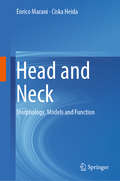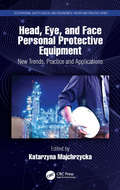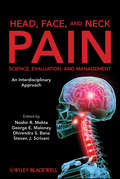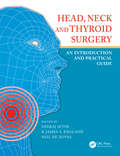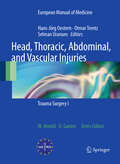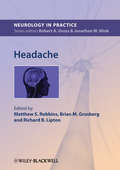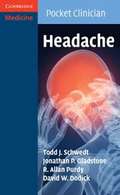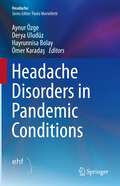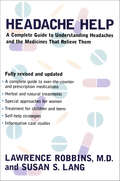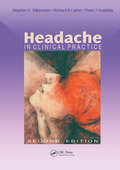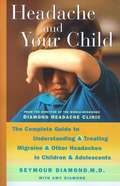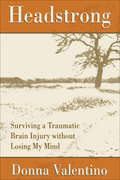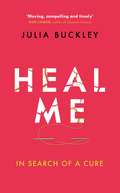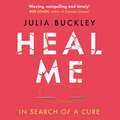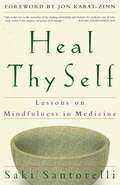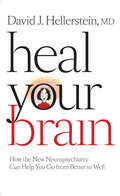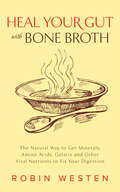- Table View
- List View
Head and Neck: Morphology, Models And Function
by Enrico Marani Ciska HeidaThis book offers a critical review of the head and neck from an anatomical, physiological and clinical perspective. It begins by providing essential anatomical and physiological information, then discusses historical and current views on specific aspects in subsequent chapters. For example, the anatomy of the skull cap or cranial vault provided in the first chapter is discussed in the context of malformation and identity, as well as the development of the bony skull, in the following chapters. These chapters provide stepping-stones to guide readers through the book. There are new fields of research and technological developments in which Anatomy and Physiology lose track of progress. One of the examples discussed is the automated face recognition. In some respects, e.g. when it comes to cancers and malformations, our understanding of the head and neck – and the resulting therapeutic outcomes – have been extremely disappointing. In others, such as injuries following car accidents, there have been significant advances in our understanding of head and neck dysfunctions and their treatment. Therefore head movements, also during sleep, and head and neck reflexes are discussed. The book makes unequivocal distinctions between correct and incorrect assumptions and provides a critical review of alternative clinical methods for head and neck dysfunctions, such as physiotherapy and lymphatic drainage for cancers. Moreover, it discusses the consequences of various therapeutic measures for physiological and biomechanical conditions, as well as puberty and aging. Lastly, it addresses important biomedical engineering developments for hearing e.g. cochlear implants and for applying vestibular cerebellar effects for vision.
Head, Eye, and Face Personal Protective Equipment: New Trends, Practice and Applications (Occupational Safety, Health, and Ergonomics)
by Katarzyna MajchrzyckaHead, Eye, and Face Personal Protective Equipment: New Trends, Practice, and Applications presents protective equipment in the context of the latest design trends, materials, and technologies. It informs the reader using basic safety principles to avoid issues with commonly used personal protective equipment (PPE), such as helmets and eye and face protectors. It provides the latest design trends in eye and face protectors to avoid optical hazards and for use in variable lighting conditions. Features: • Fills the gap on current solutions of PPE and occupational safety • Educates in reducing risk connected with using industrial safety gear • Helpful to optometrists in the selection of eye protection for people with visual impairments • Instructs the reader on choosing smart materials and safety products • Provides best practices for checking the technical condition of the equipment This book is essential for the safety professional and medical experts in the field. It provides an interdisciplinary approach to personal protective equipment using new technologies in the field. "The monograph Head, Eye, and Face Personal Protective Equipment - New Trends, Practice and Applications is a complementary and thoughtful but selected compilation of the most relevant information concerning protective helmets as well as eye and face protection. The compilation of these two protection types is the result of the common use of both protective helmets and eye and face protectors. This requires their full compatibility, both in terms of ensuring optimum safety and comfort of use. The authors have chosen the material according to the needs of people directly responsible for safety at work and users of those protectors. The main aim of the work is to popularise knowledge in the field of construction, research methods, selection and use of protective helmets and eye and face protectors. In terms of use, the authors emphasise the necessity of independent control, i.e. checking the technical condition of the equipment used by the end users. The presented monograph includes the current state of knowledge in this scope, extended by the results and summaries of the authors' own research. All requirements and research methods are given based on European (EN), international (ISO) standards and standards operating in different geographical areas. The monograph also encompasses new trends in the design of protective helmets and eye and face protectors. All this allows me to emphasize the uniqueness of this monograph in relation to previous publications in this field, both in terms of the scope and selection of information concerning protective helmets and eye and face protectors."— Ryszard Korycki, Łódź University of Technology
Head, Face, and Neck Pain Science, Evaluation, and Management
by George E. Maloney Steven J. Scrivani Noshir Mehta Dhirendra S. BanaThe most comprehensive guide ever created for head, face, and neck (HFN) pain, this multi-author book offers the very latest research and therapeutic information on this important and hugely interdisciplinary topic. A unique professional reference, it is also easy to use as a textbook within diverse educational institutions and programs. Content adheres strictly to the latest established guidelines for pain management in the medical and dental professions.
Head, Neck and Thyroid Surgery: An Introduction and Practical Guide
by Neeraj Sethi, R. James A. England and Neil de ZoysaThis book covers the clinical approach to managing head and neck pathology as it presents to the otolaryngology department. Including cervical lymphadenopathy, salivary gland disease, oral, oropharyngeal, laryngeal and hypopharyngeal lesions as well as thyroid and parathyroid diseases. Each chapter presents an evidence-based, practical, and user-friendly approach to assessing, investigating and managing these patients A practical, clinically applicable guide to managing head and neck pathology An evidence-based approach to the clear guidance provided in the book. Colour images and flow charts for quick reference Clear, concise and comprehensive, Head, Neck & Thyroid Surgery: An introduction and practical guide will be useful to trainees and clinicians in otolaryngology, maxillo-facial and plastic surgery.
Head, Thoracic, Abdominal, and Vascular Injuries
by Hans-Jörg Oestern Otmar Trentz Selman UranuesThere currently is a clear tendency to an increasing number of accidental injuries in elderly people, in sport injuries and car crashes also in countries which recently joined the European Union and candidates to join the European Union. Patients expect very good functional results even after serious injuries. But in contrast to this development, Trauma Surgery as an independent field, is not yet established in all European countries. Therefore, it seems mandatory to compile a book that covers the state-of-the-art in Trauma Surgery. The book also serves to harmonise the practice of Trauma Surgery within the European Union, and to prepare for the exam of the U.E.M.S.
Head-Related Transfer Function and Acoustic Virtual Reality
by Kazuhiro IidaThis book covers all aspects of head-related transfer function (HRTF), from the fundamentals through to the latest applications, such as 3D sound systems. An introductory chapter defines HRTF, describes the coordinate system used in the book, and presents the most recent research achievements in the field. HRTF and sound localization in the horizontal and median planes are then explained, followed by discussion of individual differences in HRTF, solutions to this individuality (personalization of HRTF), and methods of sound image control for an arbitrary 3D direction, encompassing both classic theory and state of the art data. The relations between HRTF and sound image distance and between HRTF and speech intelligibility are fully explored, and measurement and signal processing methods for HRTF are examined in depth. Here, supplementary material is provided to enable readers to measure and analyze HRTF by themselves. In addition, some typical HRTF databases are compared. The final two chapters are devoted to the principles and applications of acoustic virtual reality. This clearly written book will be ideal for all who wish to learn about HRTF and how to use it in their research.
Headache
by Matthew Robbins Brian M. Grosberg Richard LiptonThis book is a practical guide to headache medicine designed for both neurologists and general practitioners. Its expert author team introduces the principles of classification and diagnosis, and focuses in detail on the main classes of headache migraine, tension-type and trigeminal autonomic cephalgias, including cluster headache. The book's clinically focused practical approach covers unusual headache disorders, such as hemicrania continua and new daily persistent headache, and addresses the management of headache in women, children and the elderly.
Headache
by Todd J. Schwedt Jonathan P. Gladstone R. Allan Purdy David W. DodickHeadache is the most common presenting symptom in neurology and constitutes more than one-third of primary care consultations. Organized according to the presenting features of the headache (acute, episodic and chronic), this handbook provides diagnostic and treatment information for both common and uncommon causes of headache. Making maximum use of lists, bullet points, summary boxes and illustrations, it allows the reader fast access to essential information where it is needed most. Each topic is dealt with succinctly, using up-to-date knowledge and experience of the authors, all of whom are headache experts from leading clinical centers in the USA and Canada. Providing comprehensive and detailed coverage to satisfy the needs of the busy neurologist, residents in neurology, neurosurgery, psychiatry and other fields of internal medicine, this book will also be a valuable guide to practising clinicians who do not deal with headache on a regular basis.
Headache Disorders in Pandemic Conditions (Headache)
by Aynur Özge Derya Uludüz Ömer Karadaş Hayrunnisa BolayThis book provides a physician’s pathfinder for COVID specific headache disorders as well as general headache practice in a pandemic era. Practical solutions to headache management at every level are highlighted, along with the changing nature of previous headache disorders under lockdown conditions. Headache Disorders in Pandemic Conditions examines the specific nature of headache symptoms during COVID-19 infection, the secondary causes of COVID-specific headache disorders and practical issues of previous known headache disorders during a pandemic. The book also explores the effect of lockdown on headache management and changes in headache education, practice, risks and guidelines. Neurologists, headache specialists, general practitioners, medical students and residents will find this book to be a practical and clear guide to Covid-19 specific headache disorders in clinical practice.
Headache Help: A Complete Guide to Understanding Headaches and the Medications That Relieve Them
by Susan S. Lang Lawrence RobbinsMany people who suffer from headaches never consult a doctor, believing that no help is available, while others become frustrated and give up the search for relief. Fully revised and updated, this valuable book can save you time and trouble and help you stop the pain. It describes the full range of treatment options for migraines, cluster headaches, and tension headaches. It includes easy-to-understand information on the actions and side effects of hundreds of over-the-counter and prescription medications that prevent or abort headaches or dull the pain of a headache in progress. Special highlights: Details on the medications that have revolutionized migraine treatment Discussion of how hormones affect migraines Quick-reference guides to the medications that are most likely to work for your particular condition Helpful suggestions on how to describe your headache to your physician Hard-to-come-by information on headaches in children, teens, women, and people over fifty Alternative treatments, including herbs and acupuncture Self-help strategies such as relaxation techniques and biofeedback A national index of headache clinics and organizations
Headache and Comorbidities in Childhood and Adolescence
by Vincenzo Guidetti Marco A. Arruda Aynur OzgeThis book aims to provide clinicians and other practitioners and professionals with up-to-date information on how to evaluate and manage headaches in children and adolescents, highlighting the most recent recommendations. Unlike in other books on the subject, detailed attention is devoted to the various comorbidities commonly associated with headache, including psychiatric comorbidities such as depression, anxiety, attention deficit hyperactivity disorder, and learning disabilities and medical conditions such as epilepsy, vascular disorders, brain tumors, atopic disease, and obesity. The intimate link between these conditions and headache is explained with a view to enabling the reader to recognize their presence and, on that basis, to institute the most effective pharmacological or non-pharmacological treatment strategy. Moreover, knowledge of the comorbidities associated with headache will help readers to understand more fully the causes of this serious disorder and also its consequences, e. g. , for school performance, relationships, and daily activities. The authors are all international experts who care for children with headache or the other described disorders.
Headache in Children and Adolescents
by Ishaq Abu-Arafeh Aynur ÖzgeThis book assists appropriate headache assessment and decision-making in pediatrics. It covers many aspects and causes of headache disorders in children and adolescents using case studies to illustrate important points in history, examination, diagnosis, choice of management approach, therapy selection, and communication of the most helpful advice to the child and parents. Case studies have been taken from real clinical practice and presented in a consistent style. They are discussed by the authors to highlight important points in history, important positive and negative points in examination, the diagnosis, and full analysis and justification of treatment options. Headache in Children and Adolescents: A Case-Based Approach is an ideal reference for primary care physicians, paediatricians, neurologists and paediatric neurologists in their daily practice, in their consulting rooms and wards.
Headache in Clinical Practice (Uk Key Advances In Clinical Practice Ser.)
by Stephen D. SilbersteinThe authors of the first edition worked together again to revise data for the second edition of this popular volume. Based at three of the world's leading centers for the study and treatment of headache, these experts share their insights on every aspect of this common and irritating condition. In particular, the sections on migraine, cluster headache and vascular disease have been updated. Based on the classification system developed by the International Headache Society, Headache in Clinical Practice provides those interested in headache with an up-to-date compendium of current opinion, from epidemiology, pathophysiology and investigation, through options for intervention and management.
Headache—and—Your Child
by Seymour DiamondIf your child suffers from bad headaches, then you know all too well the panic and frustration they cause -- and not just for your child, who may be too young or unwell to articulate what he's feeling, but for everyone in the family. When over-the-counter medications don't work and your pediatrician doesn't have an answer, you can now turn to preeminent headache and migraine expert Dr. Seymour Diamond for help. In Headache and Your Child, he gives parents information on the most up-to-date diagnostic tools and treatment options available for this increasingly common childhood illness. Dr. Diamond's extensive experience guides you from accurate identification through the best therapy for your child's specific problem, focusing particularly on migraines -- the most common acute headache in children and adolescents. He also discusses the whole gamut of possible headache causes, from stress through more serious conditions. With this book as a guide, you'll find: Help in identifying what type of headache your child experiences so you can quickly find the most effective, appropriate treatments Step-by-step exercises for controlling pain A diet that helps identify migraine triggers Alternatives to adult medications too strong for treating children Information about biofeedback, relaxation methods, and much more.
Headstrong
by Rena BlumbergRena Blumberg provides tips and strategies for dealing with the trauma of chemotherapy.
Headstrong: Surviving a Traumatic Brain Injury without Losing My Mind (Headstrong Ser.)
by Donna ValentinoIn this inspiring memoir of brain injury and recovery, the author recounts how family, faith, and steadfast determination saved her life.Donna Valentino and her boyfriend Paul were at a resort in Texas when an ATV ride ended in tragedy. Donna crashed into an unmarked, nearly invisible chain. Suddenly their romantic weekend getaway became a nightmare of terrifying injuries—including a severe brain injury.After months of rehabilitation and a courageous battle to regain her life, Donna wrote Headstrong, recounting her remarkable journey of recovery and adaptation. In Headstrong, Donna shares the practical and positive outlook that helped her and her family not only survive, but also grow stronger through the struggle.
Heal Me: In Search of a Cure
by Julia BuckleyJulia Buckley needs a miracle. Like a third of the UK population, she has a chronic pain condition. According to her doctors, it can't be cured. She doesn't believe them. She does believe in miracles, though. It's just a question of tracking one down.Julia's search for a cure takes her on a global quest, exploring the boundaries between science, psychology and faith with practitioners on the fringes of conventional, traditional and alternative medicine. From neuroplastic brain rewiring in San Francisco to medical marijuana in Colorado, Haitian vodou rituals to Brazilian 'spiritual surgery', she's willing to try anything. Can miracles happen? And more importantly, what happens next if they do?Raising vital questions about the modern medical system, this is also a story about identity in a system historically skewed against 'hysterical' female patients, and the struggle to retain a sense of self under the medical gaze. Heal Me explains why modern medicine's current approach to chronic pain is failing patients. It explores the importance of faith, hope and cynicism, and examines our relationships with our doctors, our beliefs and ourselves.
Heal Me: In Search of a Cure
by Julia BuckleyJulia Buckley needs a miracle. Like a third of the UK population, she has a chronic pain condition. According to her doctors, it can't be cured. She doesn't believe them. She does believe in miracles, though. It's just a question of tracking one down.Julia's search for a cure takes her on a global quest, exploring the boundaries between science, psychology and faith with practitioners on the fringes of conventional, traditional and alternative medicine. From neuroplastic brain rewiring in San Francisco to medical marijuana in Colorado, Haitian vodou rituals to Brazilian 'spiritual surgery', she's willing to try anything. Can miracles happen? And more importantly, what happens next if they do?Raising vital questions about the modern medical system, this is also a story about identity in a system historically skewed against 'hysterical' female patients, and the struggle to retain a sense of self under the medical gaze. Heal Me explains why modern medicine's current approach to chronic pain is failing patients. It explores the importance of faith, hope and cynicism, and examines our relationships with our doctors, our beliefs and ourselves.
Heal Me: In Search of a Cure
by Julia BuckleyJulia Buckley needs a miracle. Like a third of the UK population, she has a chronic pain condition. According to her doctors, it can't be cured. She doesn't believe them. She does believe in miracles, though. It's just a question of tracking one down.Julia's search for a cure takes her on a global quest, exploring the boundaries between science, psychology and faith with practitioners on the fringes of conventional, traditional and alternative medicine. From neuroplastic brain rewiring in San Francisco to medical marijuana in Colorado, Haitian vodou rituals to Brazilian 'spiritual surgery', she's willing to try anything. Can miracles happen? And more importantly, what happens next if they do?Raising vital questions about the modern medical system, this is also a story about identity in a system historically skewed against 'hysterical' female patients, and the struggle to retain a sense of self under the medical gaze. Heal Me explains why modern medicine's current approach to chronic pain is failing patients. It explores the importance of faith, hope and cynicism, and examines our relationships with our doctors, our beliefs and ourselves.(p) 2017 Orion Publishing Group with Audible Ltd
Heal Thy Self
by Saki Santorelli"Perhaps our real work, whether offering or seeking care, is to recognize that the healing relationship--the field upon which patient and practitioner meet--is, to use the words of the mythologist Joseph Campbell, a 'self-mirroring mystery'--the embodiment of a singular human activity that raises essential questions about self, other, and what it means to heal thy self." --Saki SantorelliToday we are experiencing extraordinary technological advances in the diagnosis and treatment of illness while at the same time learning to take more responsibility for our own health and well-being. In this book, Saki Santorelli, director of the nationally acclaimed Stress Reduction Clinic, explores the ancient roots of medicine, and shows us how to introduce mindfulness into the crucible of the healing relationship, so that both patients and caregivers begin to acknowledge that we are all wounded and we are all whole. His approach revolutionizes the dynamics of the patient/practitioner relationship. In describing the classes at the clinic and the transformation that takes place in this alchemical process, he offers insights and effective methods for cultivating mindfulness in our everyday lives. As he reveals the inner landscape of his own life as a health care professional and we join him and those with whom he works on this journey of human suffering and courage, we become aware of and honor what is darkest and brightest within each one of us.From the Hardcover edition.
Heal Thy Self: Lessons on Mindfulness in Medicine
by Saki Santorelli"Perhaps our real work, whether offering or seeking care, is to recognize that the healing relationship--the field upon which patient and practitioner meet--is, to use the words of the mythologist Joseph Campbell, a 'self-mirroring mystery'--the embodiment of a singular human activity that raises essential questions about self, other, and what it means to heal thy self. " --Saki Santorelli Today we are experiencing extraordinary technological advances in the diagnosis and treatment of illness while at the same time learning to take more responsibility for our own health and well-being. In this book, Saki Santorelli, director of the nationally acclaimed Stress Reduction Clinic, explores the ancient roots of medicine, and shows us how to introduce mindfulness into the crucible of the healing relationship, so that both patients and caregivers begin to acknowledge that we are all wounded and we are all whole. His approach revolutionizes the dynamics of the patient/practitioner relationship. In describing the classes at the clinic and the transformation that takes place in this alchemical process, he offers insights and effective methods for cultivating mindfulness in our everyday lives. As he reveals the inner landscape of his own life as a health care professional and we join him and those with whom he works on this journey of human suffering and courage, we become aware of and honor what is darkest and brightest within each one of us.
Heal Thyself: A Doctor at the Peak of His Medical Career, Destroyed by Alcohol—and the Personal Miracle That Brought Him Back
by Olivier AmeisenHeal Thyself is the paperback edition of The End of My Addiction—a memoir of Ameisen's struggle and a call to action."[This book is] the story of the dazzling discovery of a cure that could soon be within reach of all . . . you must read this book." —David Servan-Schreiber, MD, PHD, author of Healing Without Freud or Prozac and AnticancerWhen Olivier Ameisen's book was first published, Barbara Fisher noted in The Boston Globe that "this is not your usual memoir of addiction, degradation, and redemption." His story is indeed unusual—not because he was a brilliant cardiologist who developed a profound addiction to alcohol, or because he tried numerous treatment options and none helped. His story was the story of millions of alcoholics—until he decided to take his treatment into his own hands.Searching for a cure for his deadly disease, he happened upon baclofen, a safe muscle relaxant that had recently shown promising results in studies with laboratory animals addicted to a wide variety of substances. Ameisen experimented with increasingly higher dosages until he reached a level that left him free of any craving for alcohol. That was more than six years ago.In the past year, a growing number of researchers and doctors have been inspired by Ameisen and begun prescribing baclofen and lobbying for wide-scale studies into how the drug works. Last spring, no less an authority than the leading medical journal Alcoholand Alcoholism endorsed the book. Hailing Dr. Ameisen as "a remarkable medical researcher," it summed up its assessment strongly and directly: "This book is to be recommended."
Heal Your Brain: How the New Neuropsychiatry Can Help You Go from Better to Well
by David J. HellersteinMaybe you are one of the more than 45 million people in the United States who is currently struggling with depression. Maybe anxiety keeps you from truly enjoying your job, your relationships, your life. Maybe every change you have tried to make seems to have failed and you are beginning to feel as if change is simply not possible.Author David J. Hellerstein uses the term New Neuropsychiatry to refer to a dramatically different approach to help people who have depression and anxiety disorders. Unlike Old Psychiatry, which often focused on early life issues, the New Neuropsychiatry focuses on improving present-day life and on achieving long-term remission of symptoms. Heal Your Brain combines the advances of neuroscience and medicine with the art of the storyteller to show how the New Neuropsychiatry can alter the course of your life.Dr. Hellerstein, a psychiatrist at Columbia University’s College of Physicians and Surgeons, puts this new form of psychiatry to the test. Depression and anxiety disorders damage the brain, but as Dr. Hellerstein explains, the right treatment can change the patterns of brain activity, brain cell connections, and even the brain’s anatomy. To illustrate, he relates the stories of people as they travel through various phases of New Neuropsychiatry treatment, from evaluation to therapy to remission, and illustrates how this approach can help you progress through each phase as well. The book’s compelling narrative demonstrates that, in many cases, it is possible to achieve a stable recovery and return to—or even experience for the first time—a life free of crippling anxiety and depression.
Heal Your Frozen Shoulder: An At-Home Rehab Program to End Pain and Regain Range of Motion
by Karl KnopfA COMPREHENSIVE AT-HOME REHAB, STRENGTHENING, AND MAINTENANCE PROGRAM FOR RECOVERING FROM AND PREVENTING FROZEN SHOULDERThe cause of your frozen shoulder may be a mystery, but the way to fix it is no secret. Heal Your Frozen Shoulder guides you through the entire rehabilitation process, from understanding the problem to regaining full movement. It even tells you how to avoid this debilitating condition in the future.Featuring over 200 step-by-step photos, this book presents a complete program to get your shoulder back to its best possible condition, including:• Effective movements• Progressive stretches• Gentle strengthening techniques• Long-term lifestyle adjustmentsAuthor Dr. Karl Knopf, who specializes in the needs of aging patients, emphasizes proven treatments and proper form to guarantee help with your shoulder pain regardless of your fitness level.
Heal Your Gut With Bone Broth: The Natural Way To Get Minerals, Amino Acids, Gelatin And Other Vital Nutrients To Fix Your Digestion
by Robin Westen"This is a needed and helpful antidote to the stresses of modern times that assault mental and physical health. " -Publishers Weekly A PROGRAM TO BALANCE DIGESTIVE HEALTH IN SEVEN DAYS USING TRADITIONAL QUICK-AND-EASY BONE BROTH REMEDIES The key to a healthy, happy stomach starts with bone broth. Used by our ancestors for centuries, broth restores and promotes the healthy bacteria crucial for pain-free digestion. Heal Your Gut with Bone Broth unleashes these ancient, healing powers to conquer discomfort with a seven-day program, including: *Essential mineral information *Easy-to-follow daily meal plans *Simple, organic recipes *Trigger foods to avoid *Tips for long-term health Designed to quickly relieve tummy troubles, this book also details the added benefits of broth, including stronger bones, younger skin, healthy hair and weight loss.
